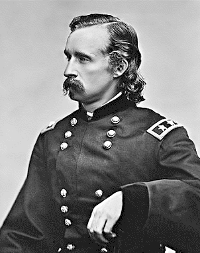On This Date In History
Benteen's Scout To The Left - Part 2
June 18, 2019
In a previous article about Benteen's scout to the left, the reason for Custer's decision to send Benteen to the left was presented. It was demonstrated that Custer was following the orders of his commanding officer General Terry when he sent Captain Benteen and his battalion to the left.
Terry's written orders for Custer stated that Custer was to check to his left as he headed up toward the Little Bighorn River. This was to be done in order to ensure that none of the Native Americans headed around his left side. Another general involved in the campaign would confirm that this was indeed what Custer was ordered to do as he headed up toward the Little Bighorn River.
General John Gibbon and General Custer were both involved in the same campaign in the summer of 1876. This campaign would lead Custer to the Little Bighorn River where he would take part in the Battle of the Little Bighorn.
During this campaign, Custer would command one column, Gibbon would command another. They were both under the leadership of General Terry. General Terry was in command of the campaign, and both Gibbon and Custer were to follow his orders.
Gibbon would write a report of the campaign. In it he would mention what Custer's orders were and what he was supposed to do as he headed up to toward the Little Bighorn River. He would write: "Lieutenant Colonel Custer was instructed to keep constantly feeling toward his left, well up toward the mountains, so as to prevent the Indians escaping in that direction, and to strike the Little Big Horn, if possible above (south) of the supposed location of the camp ..." (Windolph, 147).
Gibbon's statement serves to confirm that the orders of Terry regarding having Custer check to his left as he headed up toward the Little Bighorn were indeed Custer's orders and what he was supposed to do. Gibbon's statement, as well as Terry's orders, describe Benteen's scout to the left so well, it is clear that Custer was following orders when he sent Captain Benteen off to the left that day.
Further, Gibbon would write in his report that Custer himself agreed to the plan of which the orders were a part. Gibbon wrote in his report that on June 21st: "the plan of operation was agreed upon" (Windolph, 146).
So, in Gibbon's report, he would not only confirm what Custer was supposed to do as he headed up toward the Little Bighorn River but Gibbon would also state that he witnessed Custer himself agreeing to perform such. It would be something if we only had Terry's orders and Gibbon's confirmation of Terry's orders for Custer, but we also have Custer (the recipient of the orders) agreeing to them.
Custer's agreeing to the orders of Terry is incredibly valuable as it gives us the other side of the communication channel. In this situation, we have General Terry attempting to communicate to General Custer the orders that he is supposed to carry out. This is the first channel of communication. Custer's agreement to the orders is the second channel (or corresponding channel) of communication. An examination of these communication channels can be helpful in understanding what Custer was responsible for.
In this setting, all that is necessary for Custer to be responsible for following the orders is for him to receive them - or the first channel of communication to successfully deliver the orders to Custer. So, Terry sending the orders to Custer and him receiving them is all that is needed for Custer to be responsible for following the orders. Custer does not have to do anything further to be responsible for the orders - he need only receive them. Had Custer not received the orders, he would not have been responsible for fulfilling them.
Custer not only received the orders though, he implicitly acknowledged their receipt by agreeing to them, and also explicitly agreed to them. This certainly makes Custer responsible for following the orders.
Although the second channel of communication is not necessary for Custer to be responsible for carrying out the orders, it does provide us with valuable information. It not only confirms that Custer received the orders, but that he agreed to them as well. Frankly, the fact that there even was a second channel of communication in this situation, and that it included an agreement goes above and beyond what was necessary to make Custer responsible for following the orders. By doing so, it makes it all the more clear that Custer sent Captain Benteen off to the left that day in order to follow his orders.
Days before the battle of the Little Bighorn, General Terry provided Custer with written orders to check to his left as he headed up toward the Little Bighorn. Custer both received these orders and agreed to them. Days later, as Custer headed up toward the Little Bighorn River, he sent Captain Benteen off to the left.
If those orders of Terry were all that were available, it would be perfectly clear that Custer was following them when he sent Captain Benteen off to the left that day. However, General Gibbon also confirmed that those were indeed Custer's orders and what he was supposed to do. Gibbon would also report that he witnessed Custer agreeing to those orders. It then becomes all the more clear that Custer sent Captain Benteen off to the left on June 25th, 1876 in order to comply with his orders from General Terry.
About the Author
Tim Kloos is an online advertising professional. He helps clients with their websites, online presence, and online advertising. If you need help with any of these, feel free to contact him via the contact page.
His tech website is clevelandwebdesignplus.com.
He has also written a children's book set in the Old West.
